2007 CHEVROLET MALIBU MAXX tire pressure
[x] Cancel search: tire pressurePage 294 of 510

ABS can change the brake pressure faster than
any driver could. The computer is programmed
to make the most of available tire and road
conditions. This can help you steer around the
obstacle while braking hard.
As you brake, the computer keeps receiving
updates on wheel speed and controls braking
pressure accordingly.Remember: ABS does not change the time you
need to get your foot up to the brake pedal
or always decrease stopping distance. If you get
too close to the vehicle in front of you, you will
not have time to apply the brakes if that vehicle
suddenly slows or stops. Always leave enough
room up ahead to stop, even though you
have ABS.
Using ABS
Do not pump the brakes. Just hold the brake
pedal down �rmly and let anti-lock work for you.
You might feel a slight brake pedal pulsation
or notice some noise, but this is normal.
294
Page 305 of 510
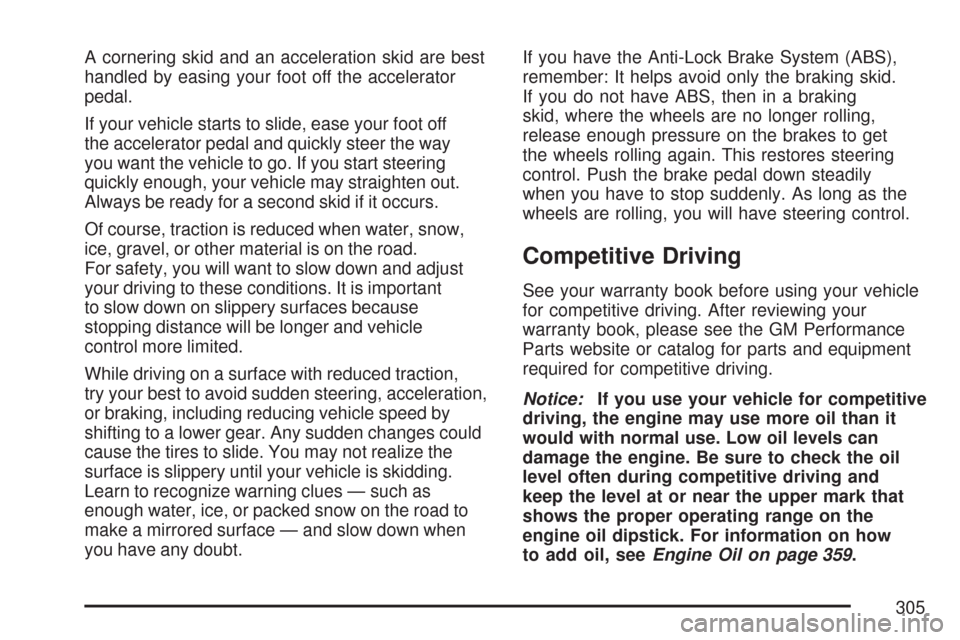
A cornering skid and an acceleration skid are best
handled by easing your foot off the accelerator
pedal.
If your vehicle starts to slide, ease your foot off
the accelerator pedal and quickly steer the way
you want the vehicle to go. If you start steering
quickly enough, your vehicle may straighten out.
Always be ready for a second skid if it occurs.
Of course, traction is reduced when water, snow,
ice, gravel, or other material is on the road.
For safety, you will want to slow down and adjust
your driving to these conditions. It is important
to slow down on slippery surfaces because
stopping distance will be longer and vehicle
control more limited.
While driving on a surface with reduced traction,
try your best to avoid sudden steering, acceleration,
or braking, including reducing vehicle speed by
shifting to a lower gear. Any sudden changes could
cause the tires to slide. You may not realize the
surface is slippery until your vehicle is skidding.
Learn to recognize warning clues — such as
enough water, ice, or packed snow on the road to
make a mirrored surface — and slow down when
you have any doubt.If you have the Anti-Lock Brake System (ABS),
remember: It helps avoid only the braking skid.
If you do not have ABS, then in a braking
skid, where the wheels are no longer rolling,
release enough pressure on the brakes to get
the wheels rolling again. This restores steering
control. Push the brake pedal down steadily
when you have to stop suddenly. As long as the
wheels are rolling, you will have steering control.
Competitive Driving
See your warranty book before using your vehicle
for competitive driving. After reviewing your
warranty book, please see the GM Performance
Parts website or catalog for parts and equipment
required for competitive driving.
Notice:If you use your vehicle for competitive
driving, the engine may use more oil than it
would with normal use. Low oil levels can
damage the engine. Be sure to check the oil
level often during competitive driving and
keep the level at or near the upper mark that
shows the proper operating range on the
engine oil dipstick. For information on how
to add oil, seeEngine Oil on page 359.
305
Page 309 of 510
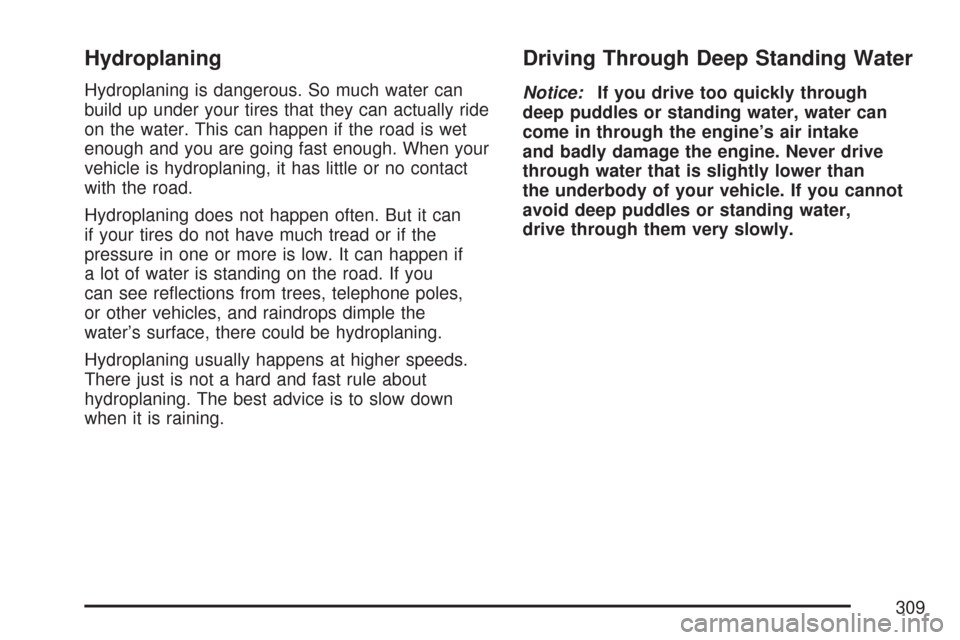
Hydroplaning
Hydroplaning is dangerous. So much water can
build up under your tires that they can actually ride
on the water. This can happen if the road is wet
enough and you are going fast enough. When your
vehicle is hydroplaning, it has little or no contact
with the road.
Hydroplaning does not happen often. But it can
if your tires do not have much tread or if the
pressure in one or more is low. It can happen if
a lot of water is standing on the road. If you
can see re�ections from trees, telephone poles,
or other vehicles, and raindrops dimple the
water’s surface, there could be hydroplaning.
Hydroplaning usually happens at higher speeds.
There just is not a hard and fast rule about
hydroplaning. The best advice is to slow down
when it is raining.
Driving Through Deep Standing Water
Notice:If you drive too quickly through
deep puddles or standing water, water can
come in through the engine’s air intake
and badly damage the engine. Never drive
through water that is slightly lower than
the underbody of your vehicle. If you cannot
avoid deep puddles or standing water,
drive through them very slowly.
309
Page 314 of 510

Here are some things you can check before a trip:
Windshield Washer Fluid:Is the reservoir
full? Are all windows clean inside and outside?
Wiper Blades:Are they in good shape?
Fuel, Engine Oil, Other Fluids:Have you
checked all levels?
Lamps:Are they all working? Are the
lenses clean?
Tires:They are vitally important to a safe,
trouble-free trip. Is the tread good enough
for long-distance driving? Are the tires
all in�ated to the recommended pressure?
Weather Forecasts:What is the weather
outlook along your route? Should you
delay your trip a short time to avoid a major
storm system?
Maps:Do you have up-to-date maps?
Highway Hypnosis
Is there actually such a condition as highway
hypnosis? Or is it just plain falling asleep
at the wheel? Call it highway hypnosis, lack of
awareness, or whatever.
There is something about an easy stretch of
road with the same scenery, along with the
hum of the tires on the road, the drone of the
engine, and the rush of the wind against the
vehicle that can make you sleepy. Do not let it
happen to you! If it does, your vehicle can leave
the road in less than a second, and you could
crash and be injured.
314
Page 325 of 510
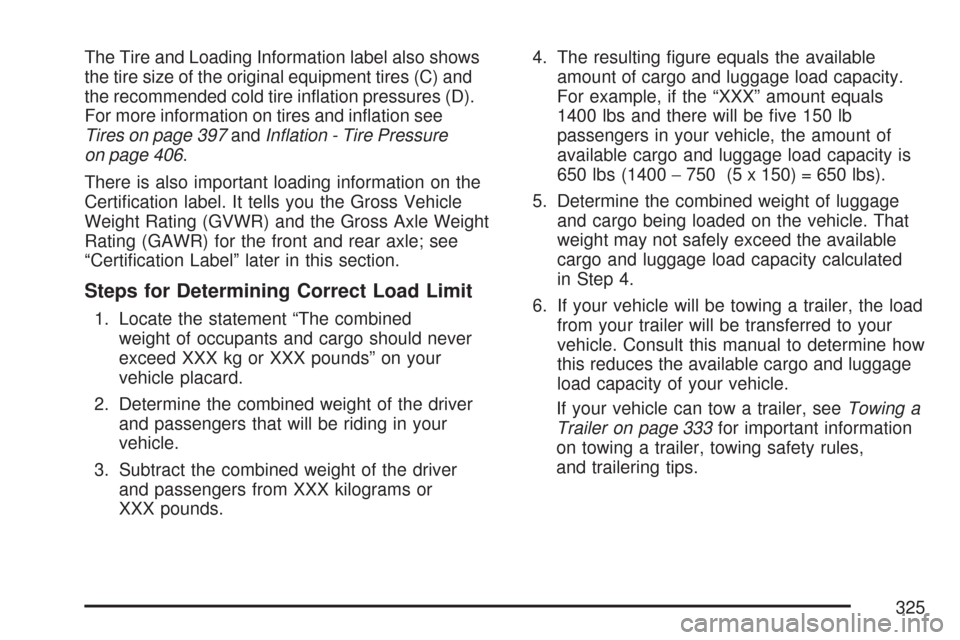
The Tire and Loading Information label also shows
the tire size of the original equipment tires (C) and
the recommended cold tire in�ation pressures (D).
For more information on tires and in�ation see
Tires on page 397andIn�ation - Tire Pressure
on page 406.
There is also important loading information on the
Certi�cation label. It tells you the Gross Vehicle
Weight Rating (GVWR) and the Gross Axle Weight
Rating (GAWR) for the front and rear axle; see
“Certi�cation Label” later in this section.
Steps for Determining Correct Load Limit
1. Locate the statement “The combined
weight of occupants and cargo should never
exceed XXX kg or XXX pounds” on your
vehicle placard.
2. Determine the combined weight of the driver
and passengers that will be riding in your
vehicle.
3. Subtract the combined weight of the driver
and passengers from XXX kilograms or
XXX pounds.4. The resulting �gure equals the available
amount of cargo and luggage load capacity.
For example, if the “XXX” amount equals
1400 lbs and there will be �ve 150 lb
passengers in your vehicle, the amount of
available cargo and luggage load capacity is
650 lbs (1400−750 (5 x 150) = 650 lbs).
5. Determine the combined weight of luggage
and cargo being loaded on the vehicle. That
weight may not safely exceed the available
cargo and luggage load capacity calculated
in Step 4.
6. If your vehicle will be towing a trailer, the load
from your trailer will be transferred to your
vehicle. Consult this manual to determine how
this reduces the available cargo and luggage
load capacity of your vehicle.
If your vehicle can tow a trailer, seeTowing a
Trailer on page 333for important information
on towing a trailer, towing safety rules,
and trailering tips.
325
Page 342 of 510

Tires............................................................ 397
Winter Tires.............................................. 398
Tire Sidewall Labeling............................... 399
Tire Terminology and De�nitions............... 403
In�ation - Tire Pressure............................. 406
High-Speed Operation............................... 407
Tire Inspection and Rotation...................... 408
When It Is Time for New Tires.................. 409
Buying New Tires...................................... 410
Different Size Tires and Wheels................ 412
Uniform Tire Quality Grading..................... 412
Wheel Alignment and Tire Balance............ 414
Wheel Replacement.................................. 414
Tire Chains............................................... 416
If a Tire Goes Flat.................................... 417
Changing a Flat Tire................................. 418
Removing the Spare Tire and Tools.......... 419
Removing the Flat Tire and Installing
the Spare Tire....................................... 422
Storing a Flat or Spare Tire and Tools
(Sedan).................................................. 428
Storing a Flat or Spare Tire and Tools
(Sedan SS)............................................ 430Storing a Flat or Spare Tire and Tools
(All MAXX Models)................................. 432
Compact Spare Tire.................................. 434
Appearance Care........................................ 435
Cleaning the Inside of Your Vehicle.......... 435
Fabric/Carpet............................................. 436
Leather...................................................... 437
Ultra Lux Suede........................................ 438
Instrument Panel, Vinyl, and Other
Plastic Surfaces..................................... 438
Care of Safety Belts.................................. 439
Weatherstrips............................................ 439
Washing Your Vehicle............................... 439
Cleaning Exterior Lamps/Lenses................ 440
Finish Care............................................... 440
Windshield and Wiper Blades.................... 440
Aluminum Wheels...................................... 441
Tires......................................................... 441
Sheet Metal Damage................................. 442
Finish Damage.......................................... 442
Underbody Maintenance............................ 442
Chemical Paint Spotting............................ 442
Section 5 Service and Appearance Care
342
Page 397 of 510
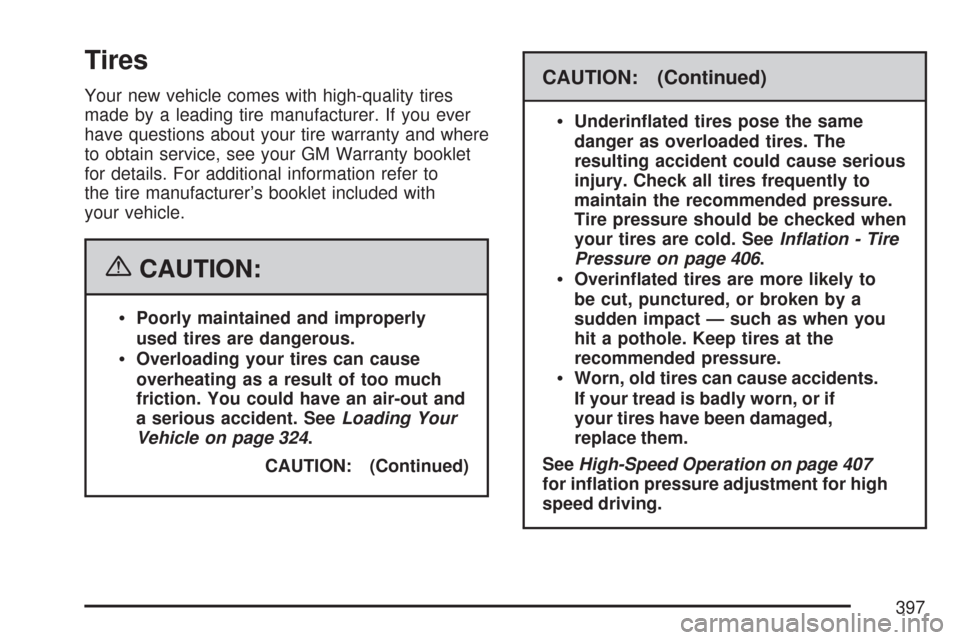
Tires
Your new vehicle comes with high-quality tires
made by a leading tire manufacturer. If you ever
have questions about your tire warranty and where
to obtain service, see your GM Warranty booklet
for details. For additional information refer to
the tire manufacturer’s booklet included with
your vehicle.
{CAUTION:
Poorly maintained and improperly
used tires are dangerous.
Overloading your tires can cause
overheating as a result of too much
friction. You could have an air-out and
a serious accident. SeeLoading Your
Vehicle on page 324.
CAUTION: (Continued)
CAUTION: (Continued)
Underin�ated tires pose the same
danger as overloaded tires. The
resulting accident could cause serious
injury. Check all tires frequently to
maintain the recommended pressure.
Tire pressure should be checked when
your tires are cold. SeeInflation - Tire
Pressure on page 406.
Overin�ated tires are more likely to
be cut, punctured, or broken by a
sudden impact — such as when you
hit a pothole. Keep tires at the
recommended pressure.
Worn, old tires can cause accidents.
If your tread is badly worn, or if
your tires have been damaged,
replace them.
SeeHigh-Speed Operation on page 407
for in�ation pressure adjustment for high
speed driving.
397
Page 398 of 510
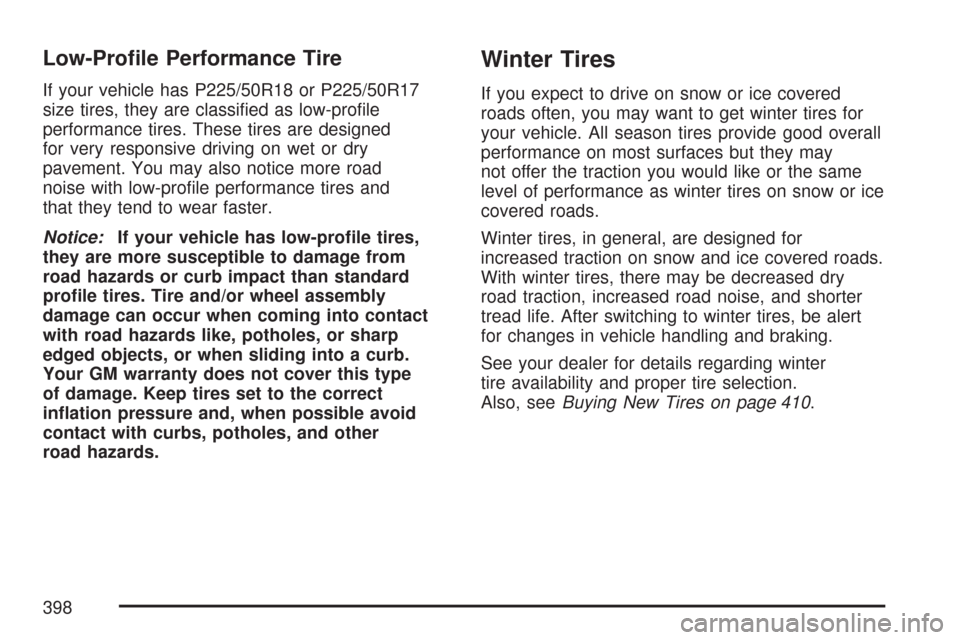
Low-Pro�le Performance Tire
If your vehicle has P225/50R18 or P225/50R17
size tires, they are classi�ed as low-pro�le
performance tires. These tires are designed
for very responsive driving on wet or dry
pavement. You may also notice more road
noise with low-pro�le performance tires and
that they tend to wear faster.
Notice:If your vehicle has low-pro�le tires,
they are more susceptible to damage from
road hazards or curb impact than standard
pro�le tires. Tire and/or wheel assembly
damage can occur when coming into contact
with road hazards like, potholes, or sharp
edged objects, or when sliding into a curb.
Your GM warranty does not cover this type
of damage. Keep tires set to the correct
in�ation pressure and, when possible avoid
contact with curbs, potholes, and other
road hazards.
Winter Tires
If you expect to drive on snow or ice covered
roads often, you may want to get winter tires for
your vehicle. All season tires provide good overall
performance on most surfaces but they may
not offer the traction you would like or the same
level of performance as winter tires on snow or ice
covered roads.
Winter tires, in general, are designed for
increased traction on snow and ice covered roads.
With winter tires, there may be decreased dry
road traction, increased road noise, and shorter
tread life. After switching to winter tires, be alert
for changes in vehicle handling and braking.
See your dealer for details regarding winter
tire availability and proper tire selection.
Also, seeBuying New Tires on page 410.
398